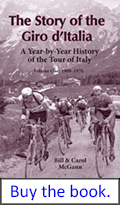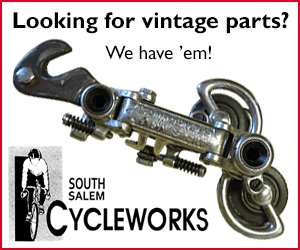

The Story of the Mondonico Framebuilding Shop

The Mondonico shop in the 1930s. Angelo is on the left and Giuseppe on the right. The racer in the middle has a pre-derailleur racing bike.

Bill and Carol McGann's book The Story of the Giro d'Italia, A Year-by-Year History of the Tour of Italy, Vol 1: 1909 - 1970 is available as an audiobook here. For the print and Kindle eBook versions, just click on the Amazon link on the right.
Our story:
The following history of the Mondonicos was the result of several talks I had with Antonio and Mauro Mondonico in late 2003.
Photos of the Mondonico shop from the 1930s.
Antonio and Mauro Mondonico build a frame, step by step
The Mondonico family might have been the oldest Italian framebuilding dynasty. Starting in 1929 with Giuseppe Mondonico and his brother Angelo, the Mondonicos personally built steel, lugged frames with their own hands until the shop closed in early 2006. That tradition has continued right up to third generation builder Mauro Mondonico who worked side by side with his father, Antonio. The family’s involvement with cycling and racing was deep and passionate.
The Mondonicos believe that their family has always lived in Concorezzo, a small village just outside Milan, near the famous Monza Motor Speedway. Giuseppe Mondonico, the founder of the Mondonico shop, and his brother Angelo had been industrial mechanics. No one knows anymore exactly what that work entailed. But the family knows that they were always mad about bicycles, cycling and cycle racing. The pictures of Binda and Girardengo in the opening credits of OLN’s Giro d’Italia a few years back were from Giuseppe Mondonico’s collection of racers and racing from that great age of cycling.
On opening the shop in 1929, Giuseppe immediately started building frames and supplying the local racers. Where Giuseppe acquired this skill, to this day, no one knows. Mauro supposes that other framebuilders had taught him. While Giuseppe built frames, Angelo did the repairs. At that time in Italy, this was a big and important business because bicycles were the primary form of transport, especially in a small village like Concorezzo.
In those pre-war years, Giuseppe built frames using both Columbus and Falck tubing. The special characteristic of Mondonico frame building, the use of pins to secure the joints instead of a tack braze, had not yet been adopted. That came later.
With the coming of the great worldwide depression in 1932, Mauro said the majority of the work done in the shop was in repairs. It was a hard job because in those days no one had much money to pay for their work. Giuseppe and Angelo had to work long hours for very small sums of money.
Giuseppe and Angelo worked in the shop together through the war. As the economy had strengthened some in the ensuing years, life was a bit kinder to the Mondonico family. They opened a coffee shop (called a “bar” in Italy) next to the bike shop.
At the end of the war, the economy and conditions in general in Italy were terrible. The famous movie “The Bicycle Thief” shows the poverty of that time, in which there could be no more valuable possession than a bicycle and the mobility it could give. After the war, Angelo left the shop to return to industrial work. He passed away in 1971.
Meanwhile, Giuseppe continued to work in the shop, building frames and repairing bikes. As Antonio grew up, he worked in the shop. As a young man, Antonio was given the job of working on the racing bikes. The frames Antonio built then used Columbus SL and SP tubing. In those days, the lugs were long and heavy, called “lastra”, being pressed and welded. The modern investment cast lugs didn’t start showing up until 1977-1978.
When Giuseppe died December 30, 1973, the shop was closed. Antonio went to work in other framebuilding shops that were looking for a skilled builder. He worked in Gianni Motta’s shop for two years, 1976 and 1977. He then moved on to the Colnago shop and built frames there until 1979. As a young man Colnago rode for a team that was headquartered in Giuseppe’s shop and would regularly visit with the Mondonico family. In Italy, the cycling world is one big family.
While Mondonico worked at the Motta shop, he also worked as a team mechanic, work was completely unrelated to his duties at Motta. This was purely an avocation born of love of the sport. Antonio had a French friend who was bringing strong riders into Italy, among them a young Sean Kelly, and Antonio was this team’s mechanic. Antonio still remembers the young amateur Kelly who came to sleep in the Mondonico home in Concorezzo before riding and winning the Piccolo Giro di Lombardia.
In 1979 Antonio Mondonico opened his own shop and the Mondonico name was again available to discerning riders. There had never been a time when Antonio didn’t build frames in his working life. But for several years, it was for others and it was those others who sold his work with their name.
Throughout the late 1970s and early 1980s, Paolo Guerciotti experienced a boom in demand for his bikes and frames. He needed a guiding hand to make sure that the frames were of high quality. Up until then, Guerciotti had several different builders building his frames. In 1984 Paolo Guerciotti and Antonio Mondonico went into partnership to produce both Guerciotti and Mondonico frames. They were wildly successful, with Antonio supervising the production of about 2,000 frames a year.
But, as they worked together, it became apparent that their goals were not really identical. Realizing this, they ended the partnership in 1989. Antonio returned to his real love: building a few, special frames, with his own hands. Instead of the big, tilt-up concrete factory workshop that housed Guerciotti-Mondonico Cycles, the Mondonico shop was in the back of the Mondonico house. There, Antonio and Mauro worked, with a constant stream of cycling and racing aficionados coming to visit and talk bikes and racing.
Mondonico has built frames that have won Classics and graced the podium of both the Tour de France and the Giro d’Italia. Sadly, as in years past, others got to take the credit for Mondonico’s work. The frames he built for Claudio Chiappucci, as with Singer for Poulidor and Masi for Merckx, received the decals of other factories.
Antonio and Mauro worked side by side in their small shop, using many of the very same tools that grandfather Giuseppe used with no change in the importance of handwork. Care and time reigned supreme. Mauro prepared the materials, cutting and mitering the tubes and filing and readying the lugs. Mauro also brazed in the fork tips, brazed on the “braze-ons” and assembled the main triangle in the jig. Antonio would braze up the main triangles, assemble the whole frame together, making sure it was all straight and correct. Mauro then did the final sandblasting and filing.
While the Mondonico specialty was lugged frames, they also built silver fillet-brazed frames. With the advent of multi-shaped mega tubes, lugs cannot always be used to join the tubes. Of course, the Mondonicos not only adopted modern, super-thinwall steel tubes in the different sizes and shapes, they also used carbon for the rear triangle. Yet, their heart was in steel. While every other builder has run from steel, the Mondonicos embraced it, loving its beautiful feel, long life and graceful appearance.
I wrote the following paragraph in February of 2004:
-
With luck, that tradition will continue long into the future as riders looking for that beautiful, perfect ride rather than the material or trend of the day, seek out the Mondonicos and one of their beautiful hand-made frames.
It was not to be. When I visited with Antonio and Mauro they told me that Torelli was their last major distributor and that at the current rate of decline in orders, they would be forced to shutter their shop. The Mondonicos were getting hammered from two sides. Not only were high-performance customers turning to carbon-fiber, the dollar was depreciating against the Euro, making Mondonico frames (and all other products of Europe) much more expensive, further eroding sales.
In September of 2005 Antonio and Mauro made a last trip to the U.S. to take orders for bespoke frames. Those frames were the last to come from the small shop in the little village of Concorezzo.
Today Mauro is the international sales manager of Columbus tubing and Antonio is retired, enjoying his well-earned leisure after a lifetime of hard work.








